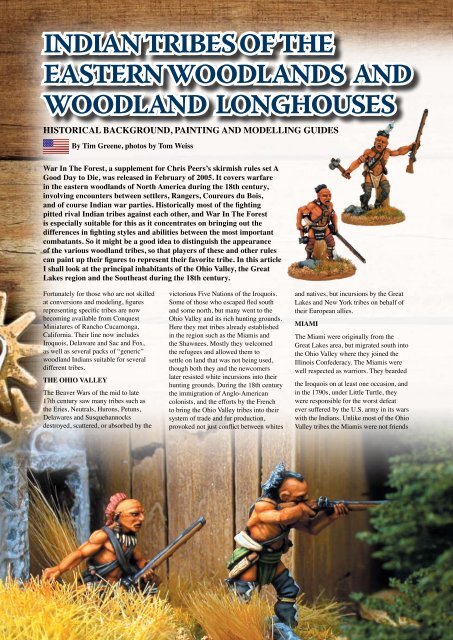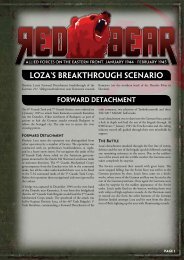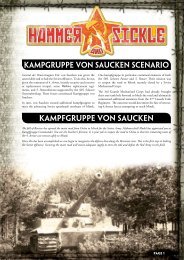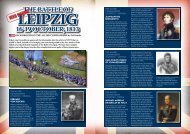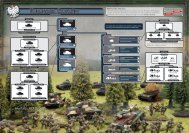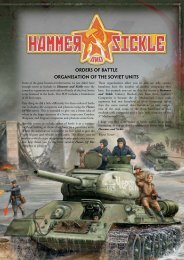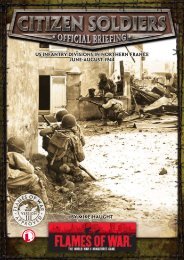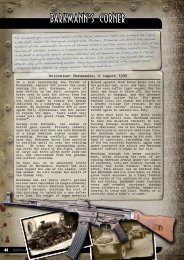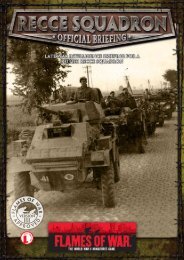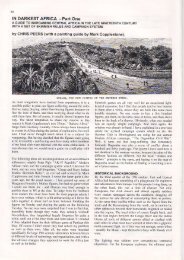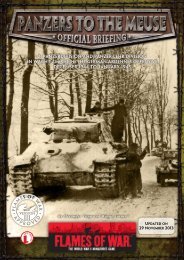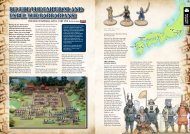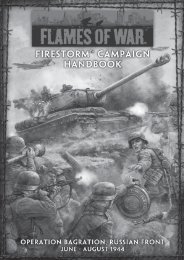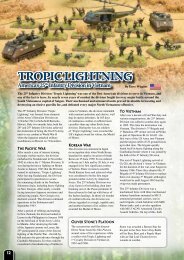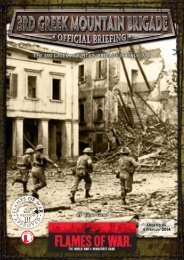INDIAN TRIBES OF THE EASTERN wOODLANDS ... - Flames of War
INDIAN TRIBES OF THE EASTERN wOODLANDS ... - Flames of War
INDIAN TRIBES OF THE EASTERN wOODLANDS ... - Flames of War
Create successful ePaper yourself
Turn your PDF publications into a flip-book with our unique Google optimized e-Paper software.
<strong>INDIAN</strong> <strong>TRIBES</strong> <strong>OF</strong> <strong>THE</strong><br />
<strong>EASTERN</strong> <strong>wOODLANDS</strong> AND<br />
wOODLAND LONgHOuSES<br />
HISTORICAL BACKGROUND, PAINTING AND MODELLING GUIDES<br />
By Tim Greene, photos by Tom Weiss<br />
<strong>War</strong> In The Forest, a supplement for Chris Peers’s skirmish rules set A<br />
Good Day to Die, was released in February <strong>of</strong> 2005. It covers warfare<br />
in the eastern woodlands <strong>of</strong> North America during the 18th century,<br />
involving encounters between settlers, Rangers, Coureurs du Bois,<br />
and <strong>of</strong> course Indian war parties. Historically most <strong>of</strong> the fighting<br />
pitted rival Indian tribes against each other, and <strong>War</strong> In The Forest<br />
is especially suitable for this as it concentrates on bringing out the<br />
differences in fighting styles and abilities between the most important<br />
combatants. So it might be a good idea to distinguish the appearance<br />
<strong>of</strong> the various woodland tribes, so that players <strong>of</strong> these and other rules<br />
can paint up their figures to represent their favorite tribe. In this article<br />
I shall look at the principal inhabitants <strong>of</strong> the Ohio Valley, the Great<br />
Lakes region and the Southeast during the 18th century.<br />
Fortunately for those who are not skilled<br />
at conversions and modeling, figures<br />
representing specific tribes are now<br />
becoming available from Conquest<br />
Miniatures <strong>of</strong> Rancho Cucamonga,<br />
California. Their line now includes<br />
Iroquois, Delaware and Sac and Fox,<br />
as well as several packs <strong>of</strong> “generic”<br />
woodland Indians suitable for several<br />
different tribes.<br />
<strong>THE</strong> OHIO VALLEy<br />
The Beaver <strong>War</strong>s <strong>of</strong> the mid to late<br />
17th century saw many tribes such as<br />
the Eries, Neutrals, Hurons, Petuns,<br />
Delawares and Susquehannocks<br />
destroyed, scattered, or absorbed by the<br />
victorious Five Nations <strong>of</strong> the Iroquois.<br />
Some <strong>of</strong> those who escaped fled south<br />
and some north, but many went to the<br />
Ohio Valley and its rich hunting grounds.<br />
Here they met tribes already established<br />
in the region such as the Miamis and<br />
the Shawnees. Mostly they welcomed<br />
the refugees and allowed them to<br />
settle on land that was not being used,<br />
though both they and the newcomers<br />
later resisted white incursions into their<br />
hunting grounds. During the 18th century<br />
the immigration <strong>of</strong> Anglo-American<br />
colonists, and the efforts by the French<br />
to bring the Ohio Valley tribes into their<br />
system <strong>of</strong> trade and fur production,<br />
provoked not just conflict between whites<br />
and natives, but incursions by the Great<br />
Lakes and New York tribes on behalf <strong>of</strong><br />
their European allies.<br />
MIAMI<br />
The Miami were originally from the<br />
Great Lakes area, but migrated south into<br />
the Ohio Valley where they joined the<br />
Illinois Confederacy. The Miamis were<br />
well respected as warriors. They bearded<br />
the Iroquois on at least one occasion, and<br />
in the 1790s, under Little Turtle, they<br />
were responsible for the worst defeat<br />
ever suffered by the U.S. army in its wars<br />
with the Indians. Unlike most <strong>of</strong> the Ohio<br />
Valley tribes the Miamis were not friends
<strong>of</strong> the French. They <strong>of</strong>ten traded with the<br />
British, but they were <strong>of</strong> an independent<br />
cast <strong>of</strong> mind, and bitterly resisted the<br />
incursions <strong>of</strong> Anglo-American settlers.<br />
Miami men wore very little; in summer<br />
just a breechclout and moccasins, plus<br />
in winter a deerskin shirt <strong>of</strong> simple cut.<br />
Deerskins were generally dyed red, and<br />
sometimes painted in the manner <strong>of</strong> the<br />
Plains Indians. Breechclouts were also<br />
red, which was a favourite Miami colour.<br />
Leggings were worn on special occasions<br />
and were knee or thigh length, gartered<br />
at the knees. The front and bottom <strong>of</strong><br />
each leg were decorated by embroidered<br />
bands. The roach was commonly worn by<br />
warriors; sometimes the entire head was<br />
shaved leaving a tuft at the crown, and<br />
other men wore their hair short except<br />
for long locks dangling in front <strong>of</strong> and<br />
behind the ears.<br />
Red facial paint was extensively used,<br />
with black sometimes added. The body<br />
was <strong>of</strong>ten painted brown. Men were also<br />
tattooed with elaborate designs, such<br />
as seven parallel lines on the nose and<br />
cheeks, and ten on the chin.<br />
SHAWNEE<br />
The Shawnee (meaning “southerners”)<br />
were wanderers who were <strong>of</strong>ten invited<br />
by other tribes to live among them<br />
because <strong>of</strong> their reputation as fighters.<br />
An Algonquian speaking people closely<br />
related to the Sac and Fox, they inhabited<br />
a region which stretched from the<br />
Great Lakes region to the Carolinas.<br />
The Shawnee claimed to have been<br />
responsible for preventing the Iroquois<br />
from completing their conquest <strong>of</strong> the<br />
Ohio Valley, and they resisted white<br />
expansion more fiercely than any other<br />
tribe. They threw up a great leader in<br />
Tecumseh, who in 1811 came closer<br />
than anyone to creating a pan-Indian<br />
confederacy which might have slowed or<br />
even halted the westward expansion <strong>of</strong><br />
the White frontier.<br />
In their overall appearance they were<br />
rather plain compared to the other tribes.<br />
Men wore tanned leather breechclouts<br />
with a short flap in front, and deerskin<br />
leggings gartered below the knee, fringed<br />
along the side seams and fastened to a<br />
belt with straps. Other ornamentation was<br />
rarely used; when it was, arrow, chevron,<br />
and zigzag designs were preferred. The<br />
roach was rarely worn. Men either shaved<br />
their heads in front and attached feathers<br />
at the back, or left the hair long and<br />
loose. Some wrapped their long woven<br />
sashes round their heads like turbans.<br />
Face paint was usually red. Some <strong>of</strong><br />
the Perry Miniatures figures from their<br />
American <strong>War</strong> <strong>of</strong> Independence range<br />
which have the front <strong>of</strong> the head shaved<br />
and the hair left long at the back, or the<br />
large scalplocks and no roach, will do<br />
quite well for Shawnees.<br />
DELAWARE<br />
The Leni-Lenape, as the Delaware<br />
called themselves, were once a powerful<br />
confederacy along the Atlantic coast.<br />
They had an advanced culture, including<br />
a form <strong>of</strong> picture writing, and the other<br />
Algonquian speaking tribes regarded<br />
them as the originators <strong>of</strong> their culture,<br />
calling them “grandfathers”. Decimated<br />
by disease and wars with the Europeans<br />
and Iroquois during the 16th and 17th<br />
centuries, they were eventually driven<br />
first into Pennsylvania and then Ohio.<br />
The Iroquois claimed to have defeated<br />
them and reduced them to the status <strong>of</strong><br />
“women” (meaning that they surrendered<br />
their political independence to the<br />
League). Despite this the Delawares<br />
were regarded as first rate woodsmen<br />
and formidable warriors, who had a<br />
reputation for ferocity despite mostly<br />
being <strong>of</strong> only medium stature. In the 18th<br />
century they were bitter enemies <strong>of</strong> the<br />
Anglo-Americans, who took their best<br />
lands in Pennsylvania and eastern Ohio.<br />
(This was done with the permission <strong>of</strong><br />
the Iroquois, who did a brisk business<br />
selling the lands <strong>of</strong> the tribes they had<br />
supposedly conquered to the British!)<br />
Delaware warriors wore breechclouts<br />
with flaps in front and back, and thigh<br />
length leggings <strong>of</strong> deerskin fastened at<br />
the sides with thongs and gartered just<br />
below the knees. Tanned deerskin cloaks<br />
were worn fastened at the neck leaving<br />
the arms free, and were sometimes draped<br />
over one shoulder and belted. Clothing<br />
was decorated with concentric circles or<br />
spirals <strong>of</strong> shell beads. Winter robes <strong>of</strong> fur<br />
(bear, wildcat, beaver, wolf and raccoon<br />
sewn together) were also worn. Most<br />
men wore their hair long and loose, either<br />
with a wampum-decorated headband<br />
or gathered at the back like a ponytail,<br />
though some followed the dominant<br />
fashion in the woodlands <strong>of</strong> shaving the<br />
head and leaving a scalplock hanging<br />
behind. Sometimes a brush <strong>of</strong> stiff hair<br />
was left standing two to three inches high<br />
from forehead to nape, combined with<br />
a scalplock. Chiefs might wear a crown<br />
<strong>of</strong> upstanding turkey feathers dyed red.<br />
Delawares tattooed their faces and bodies<br />
with animal figures. The face was <strong>of</strong>ten<br />
painted with geometric or animal designs<br />
in black, red, white, and yellow. Figures<br />
are easily obtained: Conquest produce<br />
a pack, and the Stockbridge Indians in<br />
the Perry Miniatures range (who were<br />
basically the same people) would also do<br />
nicely.<br />
HURON OR WyANDOT<br />
These people were the remnants <strong>of</strong> the<br />
Iroquoian speaking confederacies which<br />
had been smashed by their relatives<br />
<strong>of</strong> the Five Nations during the 17th<br />
century. The scattered refugees reunited<br />
in the Great Lakes region under the<br />
name <strong>of</strong> one <strong>of</strong> their original tribes, the<br />
Hurons, who were staunch allies <strong>of</strong> the<br />
French. The Wyandots were a faction<br />
<strong>of</strong> these people who emigrated to the<br />
Sandusky region <strong>of</strong> the Ohio Valley.<br />
The Hurons ended up in Minnesota,<br />
and throughout the 18th century they<br />
tried, in company with their allies the<br />
Ottawa, to drive the Sioux from their<br />
lands. (They were largely unsuccessful in<br />
this, despite possessing more guns than<br />
their enemies.) The Wyandots joined the<br />
Delawares and Shawnees in opposing the<br />
settlement <strong>of</strong> the Ohio Valley by Whites.<br />
Both Wyandots and Hurons resembled<br />
their Algonquian speaking allies in their<br />
way <strong>of</strong> life more than they did their<br />
Iroquoian cousins, though they were<br />
never the woodsmen or canoemen that<br />
the Algonquians were.<br />
Huron and Wyandot men wore fitted<br />
breechclouts, with flaps to mid thigh in<br />
front and back, and thigh length leggings<br />
tied to a belt with thongs. Sleeveless<br />
tunics or ponchos were favoured in cooler<br />
weather. Decoration on the clothing<br />
consisted <strong>of</strong> bands <strong>of</strong> quillwork or moosehair<br />
embroidery in reds and browns.<br />
Garments were sometimes painted in<br />
floral designs, and occasionally had long<br />
fringes attached. A variety <strong>of</strong> hair styles<br />
were worn. These included shaved heads<br />
with the roach; shaved heads with a tuft<br />
left on top and a scalplock; half the head<br />
shaved with the hair left long on the other<br />
half; hair worn loose; or in two large rolls<br />
over the ears with the rest <strong>of</strong> the head<br />
shaved. A chief’s headdress was a cap <strong>of</strong><br />
feathers with an embroidered headband<br />
rising to a peak at the front. Both<br />
tribes dyed their buckskin clothing and<br />
moccasins black. Few men were tattooed,<br />
but faces and bodies were painted with<br />
geometric designs or representations <strong>of</strong><br />
animals and humans. Black, red, green<br />
and violet paints were most popular.<br />
MINGO<br />
The Mingos were a dissident Iroquois<br />
faction who settled in the lands which the<br />
Five Nations claimed to have conquered<br />
from the local tribes. They usually<br />
ignored the policies <strong>of</strong> the League, and<br />
were generally pro-French. Their towns<br />
<strong>of</strong>ten contained members <strong>of</strong> all the local<br />
tribes, including Delawares, Wyandots,<br />
and Shawnees. They were very bitter<br />
against the white settlers, especially<br />
after some <strong>of</strong> these killed Chief Logan’s<br />
family in a very brutal manner.<br />
Men wore tanned leather breechclouts<br />
with rather short ends at front and<br />
back. Knee length kilts held in place<br />
with a belt were worn for ceremonies.<br />
Leggings were loose and long, partially<br />
covering the moccasins and dragging on<br />
the ground. They were sewn up in front<br />
with an embroidered strip covering the<br />
seam, gartered above the knee, and rarely<br />
OLD west<br />
1800 - 1900
fringed. Simple mid-length tunics were<br />
worn, made <strong>of</strong> two pieces <strong>of</strong> buckskin<br />
fastened at the shoulders and fringed<br />
on the bottom. Decoration was in arrow<br />
and chevron designs, or white beadwork<br />
in lacy patterns on a dark (<strong>of</strong>ten blue)<br />
background. Heads were shaved except<br />
for a scalplock. Many wore the roach.<br />
Chiefs wore a gustoweh skull cap on a<br />
frame, with overlapping layers <strong>of</strong> feathers<br />
hanging down all round, and between one<br />
and three feathers held upright in a bone<br />
socket. A black rectangle or three stripes<br />
were painted on each cheek. Many men<br />
sported spectacular tattooing, consisting<br />
<strong>of</strong> double-curve motifs, geometric<br />
designs and clan crests. (All the notes<br />
on the appearance <strong>of</strong> the Mingos apply<br />
equally well to the Iroquois tribes <strong>of</strong><br />
the Five Nations - Senecas, Cayugas,<br />
Oneidas, Onondagas and Mohawks - who<br />
were still based in New York state. This<br />
<strong>of</strong> course means that Iroquois figures<br />
could be used to represent Mingos.)<br />
<strong>THE</strong> GREAT LAKES<br />
The tribes living in the Great Lakes<br />
region, north <strong>of</strong> the Ohio Valley, were<br />
originally mostly speakers <strong>of</strong> various<br />
Algonquian languages. They did some<br />
farming, but mainly lived by hunting<br />
and fishing. In the 1680s and 1690s there<br />
was a massive invasion <strong>of</strong> the area by the<br />
survivors <strong>of</strong> tribes broken by Iroquois<br />
attacks. These refugees were remnants<br />
<strong>of</strong> confederacies like the Huron, Erie,<br />
and Neutrals, plus various Algonquin<br />
speaking bands. They forced their way<br />
into the Great Lakes region, slaughtering<br />
and driving out the indigenous nations.<br />
Eventually the French intervened.<br />
They rallied the Great Lakes tribes, and<br />
persuaded them to make peace with the<br />
invaders and together turn on the Iroquois<br />
and their British allies. Eventually a<br />
measure <strong>of</strong> stability returned to the<br />
region, which remained a bastion <strong>of</strong><br />
anti-British sentiment through Pontiac’s<br />
rebellion in the 1760s.<br />
CHIPPEWA AND OjIBWA<br />
The Chippewas were a numerous tribe<br />
<strong>of</strong> hunter-gatherers who lived between<br />
Hudson’s Bay and the Great Lakes. They<br />
consisted <strong>of</strong> many loosely organized<br />
bands. Their closest relatives were the<br />
Ottawa and the Potawatomi, and together<br />
these peoples were known as the Three<br />
Fires Confederacy. The western bands <strong>of</strong><br />
the Chippewa generally went under the<br />
name Ojibwa, and most <strong>of</strong> the remarks<br />
here also apply to them. The Chippewa<br />
were formidable warriors, who more<br />
than held their own against the Iroquois<br />
and were a major factor in stopping their<br />
invasion <strong>of</strong> the Great Lakes region. They<br />
were among the staunchest allies <strong>of</strong> the<br />
French, and frequently fought the British<br />
and other tribes on their behalf. <strong>War</strong><br />
parties frequently went south against the<br />
Catawba after those people began killing<br />
French trappers.<br />
Chippewa men wore breechclouts with<br />
long flaps in front and back. Sometimes<br />
a kilt-like garment fringed at the bottom<br />
was worn instead. Leggings were closefitting;<br />
either gartered below the knees,<br />
or thigh length and tied with thongs or<br />
straps to a belt. Buckskin ponchos were<br />
common in cool weather. Men wore their<br />
hair loose, or occasionally braided with<br />
a scalplock at the back; warriors liked<br />
to stiffen this scalplock so it stood up<br />
straight for several inches. Red, black,<br />
green and yellow paint was used for war,<br />
with green spots sometimes painted in an<br />
arc across the face.<br />
Ojibwa men favoured buckskin shirts,<br />
embroidered and painted, with attached<br />
scalplocks like those <strong>of</strong> the Plains tribes.<br />
Leggings were decorated with porcupine<br />
quillwork and moosehair embroidery. Skin<br />
garments were frequently dyed black and<br />
edged with short fringes. Some men wore<br />
their hair long, hanging naturally. Others<br />
wore it in two or four braids. Successful<br />
warriors, in particular, shaved the head<br />
except for a brush or roach on top and a<br />
scalplock hanging behind. Others coiled<br />
their braids on top <strong>of</strong> their heads and<br />
wrapped them in bark to make them stand<br />
erect. Hair could be painted with red or<br />
yellow paint. Ojibwa moccasins were<br />
<strong>of</strong>ten dyed black. Faces and bodies were<br />
painted in dots, bars, patches and other<br />
simple designs using red ochre and black<br />
charcoal or soot. Men were extensively<br />
tattooed, and their bodies were <strong>of</strong>ten<br />
covered with various designs.<br />
FOx<br />
The Fox were an Algonquian speaking<br />
people who may have originally come<br />
from the Michigan Peninsula. They<br />
were part <strong>of</strong> the confederacy known as<br />
the Fire Nation, which also included the<br />
Sac, Kickapoo and Mascouten who had<br />
been driven into Wisconsin during the<br />
invasions <strong>of</strong> the Great Lakes region by<br />
the refugees fleeing from the Iroquois.<br />
The Fox were especially formidable<br />
fighters, but in the 18th century they<br />
unwisely chose to single-handedly<br />
oppose the French, while simultaneously<br />
alienating most <strong>of</strong> their neighbours. This<br />
resulted in the near destruction <strong>of</strong> the<br />
Fox Nation. The remnants were taken in<br />
by the Sacs and incorporated into what<br />
became known as the Sac (or Sauk) and<br />
Fox Nation.<br />
Fox men wore breechclout and moccasins<br />
in summer, with thigh length leggings<br />
and a shirt added in winter. Leggings had<br />
fringes at the sides, and large pointed<br />
flaps at the bottom which covered most<br />
<strong>of</strong> the foot. They were seamed up the<br />
front and sometimes had garters <strong>of</strong> fur.<br />
Garments were lavishly decorated with<br />
geometric quillwork and, later in the<br />
period, floral and traditional moosehair<br />
embroidery. This decoration was much<br />
more elaborate than among the allied Sac.<br />
Clothing could also be painted in bright<br />
hues in solids and stripes, or figures and<br />
designs like those <strong>of</strong> the Miami. The
oach hairstyle was almost universal,<br />
though there was one section <strong>of</strong> the tribe<br />
who wore their hair long and loose.<br />
Other men shaved the head, leaving a tuft<br />
running from front to back or side to side,<br />
and a scalplock hanging from the crown.<br />
The tuft was sometimes shaved, leaving<br />
just the scalplock and roach, and the top<br />
part <strong>of</strong> the shaved skull was then painted<br />
red. Some Fox warriors wore a turban<br />
made <strong>of</strong> otter fur, and a few sported<br />
buffalo horn headdresses captured from<br />
enemies like the Sioux and Iowa. They<br />
liked red and black pigments, and some<br />
chiefs illustrated by a European artist<br />
had their faces painted blue. Yellow, red<br />
and black stripes could be painted on the<br />
lower half <strong>of</strong> the face. Among the Fox<br />
and the Sac, hands painted on the body<br />
denoted an enemy killed in hand to hand<br />
combat. Sac and Fox figures are available<br />
in the Conquest range.<br />
SAC<br />
Closely related to the Fox and Kickapoo,<br />
the Sac were allies <strong>of</strong> the French. They<br />
moved south into the territory <strong>of</strong> the<br />
Illinois Confederacy in the 18th century,<br />
occupying the area around the Rock<br />
and Mississippi Rivers. Sac men wore<br />
the usual breechclout and moccasins in<br />
summer, with a robe added in winter. The<br />
breechclouts, usually painted red, were <strong>of</strong><br />
the fitted type without flaps. Hip length<br />
leggings <strong>of</strong> deer or elk skin were also<br />
worn. These were whitened with clay and<br />
decorated with porcupine quillwork and<br />
fringes at the sides. Geometric quillwork<br />
and abstract floral moosehair embroidery<br />
were used for decoration. Hairstyles and<br />
headdresses were similar to those <strong>of</strong> the<br />
Fox. For painting the face and body,<br />
white and black pigments were favoured,<br />
with the eyes <strong>of</strong>ten rimmed in red paint.<br />
White stripes were sometimes painted<br />
round the arms and legs.<br />
OTTAWA<br />
The Ottawa lived too far north for<br />
agriculture, their land was poor in the<br />
wild rice so abundant in the land <strong>of</strong><br />
the Chippewas, and there were few fur<br />
bearing animals in their country. So they<br />
had little choice but to become traders.<br />
This honed their diplomatic skills,<br />
and they eventually produced one <strong>of</strong><br />
the greatest Native American leaders,<br />
Pontiac, who led a great revolt against<br />
the British in 1763. The Ottawas had a<br />
reputation for cunning, treachery and<br />
cruelty, but proved loyal to the French,<br />
and became the nucleus <strong>of</strong> anti-British<br />
hostility after the French and Indian <strong>War</strong>.<br />
The French <strong>of</strong>ten remarked on the<br />
prevalence <strong>of</strong> nudity among the Ottawas.<br />
Men usually wore only a robe and<br />
moccasins, though sometimes a fitted<br />
leather breechclout was seen with<br />
flaps in front and back, decorated with<br />
quillwork. Leggings, when worn, were<br />
simple thigh length tubes <strong>of</strong> hide, fringed<br />
on the outside seams and gartered just<br />
below the knees. Some men favoured<br />
the roach, but the head was more <strong>of</strong>ten<br />
shaved except for a scalplock hanging<br />
from the crown, and a central tuft running<br />
front to back and decreasing in height<br />
towards the back. Hair could also be<br />
worn in two or four braids sometimes<br />
wrapped in fur or thongs. Yet others<br />
allowed the hair to hang loose or shaved<br />
it all except for a tuft at the crown. Men<br />
were commonly tattooed with designs<br />
including lizards, snakes, and geometrical<br />
figures, sometimes covering the entire<br />
body. The face and body were painted in<br />
red, brown, green and black.<br />
POTAWATOMI<br />
The Potawatomi were close relatives <strong>of</strong><br />
the Chippewa and Ottawa. They wore<br />
tanned leather breechclouts with quillwork<br />
bands at the bottom, and flaps hanging<br />
down to the knees at front and back.<br />
Leggings were deerskin, thigh length,<br />
fringed down the side seams and gartered<br />
below the knees. Unseamed pieces <strong>of</strong><br />
tanned skin were worn for shirts. The<br />
Potawatomi decorated these garments with<br />
quillwork in geometric designs, and with<br />
dyed moosehair in modified floral patterns.<br />
<strong>War</strong>riors generally shaved their heads<br />
and wore the roach. The most common<br />
style was a tuft <strong>of</strong> hair from front to back<br />
with a scalplock hanging down; a single<br />
eagle feather was <strong>of</strong>ten added at the back.<br />
<strong>War</strong>riors painted their faces red and black,<br />
the upper face frequently being all black,<br />
and the eyes ringed in red and/or black.<br />
WINNEBAGO<br />
The Winnebago were a Siouan speaking<br />
tribe from Wisconsin. Early traditions<br />
connect the Winnebagos with the<br />
northernmost Mound Builder centre<br />
<strong>of</strong> Azatalan. Perhaps because <strong>of</strong> this<br />
exalted ancestry they were said to be<br />
haughty and arrogant, looking down<br />
on the surrounding tribes as inferior.<br />
They also had a reputation for treachery<br />
and cannibalism. The Winnebagos<br />
occasionally sent warriors to help the<br />
French, but mostly they stayed neutral.<br />
They wore breechclouts consisting <strong>of</strong><br />
an underpiece and two separate<br />
apron flaps, or a long, single<br />
piece <strong>of</strong> material ending in<br />
flaps. These were <strong>of</strong> elk or<br />
deerskin, painted red or black.<br />
Leggings were also made <strong>of</strong> elk or deer<br />
hide. They were usually knee length<br />
and gartered below the knees. In cooler<br />
weather a poncho type shirt reaching to<br />
the hips was worn. Shirts and leggings<br />
had short fringes. Men wore their hair<br />
either in two braids, or just clumped on<br />
either side and fastened with thongs.<br />
A few men wore the roach for war,<br />
usually with a roach spreader and one<br />
or two feathers inserted in a swiveling<br />
socket. Headdresses made <strong>of</strong> rawhide<br />
with buffalo horns and grizzly-bear<br />
claws could also be worn. <strong>War</strong>riors<br />
painted their faces and bodies red, black<br />
or green. A hand painted on the face or<br />
breast signified a man who had killed an<br />
enemy, and men who had gone on the<br />
warpath in winter commemorated this<br />
feat by painting their legs white.<br />
<strong>THE</strong> SOU<strong>THE</strong>AST<br />
South <strong>of</strong> the Ohio Valley, and stretching<br />
from the Gulf <strong>of</strong> Mexico to the Atlantic,<br />
was a region inhabited by some <strong>of</strong> the<br />
most advanced tribes in North America<br />
- so much so that they later became<br />
known as the Five Civilized tribes.<br />
Despite this the Southeastern peoples<br />
were extremely warlike, and bitterly<br />
resisted both the incursions <strong>of</strong> the<br />
Iroquois from the north and the advance<br />
<strong>of</strong> White settlement.<br />
CATAWBA<br />
The Catawba were one <strong>of</strong> a number<br />
<strong>of</strong> Siouan-speaking tribes inhabiting<br />
the Carolina Piedmont country, east <strong>of</strong><br />
the Appalachians. During the late 17th<br />
century they absorbed other tribes which<br />
had been weakened by the English<br />
colonists and the diseases they had<br />
brought with them, so that by the early<br />
18th century they were an agglomeration<br />
<strong>of</strong> many different nations, and a variety<br />
<strong>of</strong> languages could be heard in the<br />
Catawba towns. They allied themselves<br />
closely to the colony <strong>of</strong> South Carolina,<br />
and fought loyally for the British<br />
throughout the Colonial <strong>War</strong>s. They<br />
helped the British destroy French posts<br />
along the Mississippi Gulf Coast, and<br />
the French responded by embroiling<br />
their Great Lakes allies in constant wars<br />
with the Catawba. The Iroquois also<br />
raided as far south as the Carolinas, and<br />
a bitter and protracted war broke out<br />
between the League and the Catawbas,<br />
who stubbornly refused to be beaten<br />
into submission. This situation was<br />
much to the discomfiture <strong>of</strong> the British,
who relied on both tribes as allies. The<br />
Catawbas were ferocious warriors with<br />
a fearsome reputation. Early in the 18th<br />
century they helped South Carolina<br />
destroy the Tuscaroras, and drove the<br />
remnants north to become the Sixth<br />
Nation <strong>of</strong> the Iroquois. They also fought<br />
the Cherokees, Delawares and Shawnees<br />
- driving several bands <strong>of</strong> the latter<br />
from North Carolina into Pennsylvania.<br />
However constant warfare and disease<br />
steadily reduced their numbers as the<br />
18th century wore on.<br />
Already by the early 18th century the<br />
Catawbas had long been under British<br />
influence. While buckskin garments<br />
were still seen, most men wore muslin,<br />
calico or linen. Breechclouts and<br />
leggings were <strong>of</strong>ten made <strong>of</strong> red or<br />
blue wool strouding. Shirts might<br />
be decorated with complex patterns.<br />
Unlike their neighbours Catawba men<br />
wore their hair long, <strong>of</strong>ten pulled back<br />
into a ponytail style. The roach was<br />
apparently not worn, but some chiefs<br />
wore headdresses <strong>of</strong> upstanding turkey<br />
feathers. One <strong>of</strong> the most distinctive<br />
features <strong>of</strong> their appearance was<br />
the practice <strong>of</strong> cranial deformation,<br />
which led their enemies to call them<br />
“flatheads” - though this custom had<br />
probably died out by the mid 18th<br />
century. Moccasins were worn on the<br />
war trail, although the men <strong>of</strong>ten went<br />
barefoot at home. The Catawba had a<br />
very distinctive style <strong>of</strong> war paint: the<br />
lower face was black or red, with a<br />
white circle around one eye and a black<br />
circle around the other. Combined with<br />
their deformed skulls the effect must<br />
have been terrifying. Ignoring the<br />
“flat heads”, the Conquest Delaware<br />
figures with clothing painted as cloth<br />
instead <strong>of</strong> buckskin would make<br />
excellent Catawbas.<br />
CHEROKEE<br />
The Cherokee were the southernmost<br />
<strong>of</strong> the Iroquoian speaking tribes. Like<br />
their Iroquoian cousins they were very<br />
warlike, though they fared poorly<br />
against both the Catawbas and the<br />
Chickasaws. Conflict with their cousins<br />
<strong>of</strong> the Five Nations was common, with<br />
the Iroquois usually the aggressors.<br />
The Cherokees <strong>of</strong>ten responded to an<br />
Iroquois raid by sending one warrior<br />
north single-handed to collect a scalp.<br />
Cherokees and Shawnees also fought<br />
constantly, and the honours were about<br />
even. The formidable warriors <strong>of</strong> the<br />
Chickasaw, Catawba and Shawnee<br />
aside, the Cherokee more than held<br />
their own against other Indian enemies.<br />
They usually sided with the British,<br />
but early in the 19th century it became<br />
apparent that the Americans were now<br />
too powerful to be resisted, and they<br />
reluctantly agreed to be moved west.<br />
Skin breechclouts <strong>of</strong> the apron type were<br />
universal. Knee length leggings could<br />
also be worn, and in cooler weather a<br />
light skin poncho. From the middle <strong>of</strong><br />
the 18th century European style cloth<br />
shirts became available. Quillwork was<br />
rare, but some floral beadwork was done<br />
on pouches and shoulder bags, with<br />
circular motifs being the most popular.<br />
Men shaved their heads except for a<br />
roach running from front to back on<br />
top <strong>of</strong> the head, <strong>of</strong>ten with a fringe <strong>of</strong><br />
hair along the forehead. The roach was<br />
frequently augmented by opossum or<br />
deer hair dyed red or yellow. Symbols<br />
such as flowers, animals and stars were<br />
tattooed on the arms, torso, and thighs.<br />
<strong>War</strong>riors used red paint to signify<br />
success, blue for trouble or defeat,<br />
black for death, and white for peace and<br />
happiness. Red and black were therefore<br />
the most popular war colours.
CHICKASAW<br />
If the Great Lakes was a French<br />
stronghold, the Southeast was a British<br />
one. Probably the most formidable allies<br />
the British had in the region were the<br />
Chickasaws. They were closely related<br />
to the Choctaws, and both tribes have<br />
a tradition <strong>of</strong> having been originally<br />
one people. Despite this, by the 18th<br />
Century they were bitter enemies, the<br />
Choctaws being the main French allies<br />
in the Southeast. The Chickasaws fought<br />
no fewer than five wars against the<br />
French and whipped them every time.<br />
They also fought and beat virtually<br />
every other tribe within reach <strong>of</strong> them<br />
- particularly the Illinois Confederacy,<br />
the Shawnees and the Cherokees. In fact<br />
the Chickasaws - who became known as<br />
“the unconquered and unconquerable”<br />
- never lost a war in their recorded<br />
history, and kept their record perfect by<br />
packing up and migrating to the west<br />
in the 1830s when it became apparent<br />
that the Whites were too strong for<br />
them. Like their Creek cousins they<br />
were Muskhogean speakers who divided<br />
their tribe into two clans, or moieties<br />
- the White (or peace) and Red (or<br />
war), who occupied separate Red and<br />
White towns. Some scholars think the<br />
Chickasaws may have originally been<br />
the Red moiety <strong>of</strong> the larger Choctaw-<br />
Chickasaw tribe, which might account<br />
for their extreme pr<strong>of</strong>iciency in war.<br />
Deerskin breechclouts were universally<br />
worn. In cooler weather a light skin<br />
poncho was popular, and from the<br />
middle <strong>of</strong> the 18th century cloth shirts<br />
were <strong>of</strong>ten seen. Men shaved their heads<br />
except for a roach from front to back<br />
on top <strong>of</strong> the head, <strong>of</strong>ten with a fringe<br />
<strong>of</strong> hair along the forehead. They would<br />
fasten feathers, the skin <strong>of</strong> a hawk, or a<br />
red bird’s wing to this scalplock. At the<br />
crown <strong>of</strong> the head a large conch-shell<br />
bead was sometimes fixed. A skein <strong>of</strong><br />
threads might be wrapped around the<br />
head, with the ends hanging down like<br />
tassels. Like other Southeastern tribes<br />
the Chickasaw <strong>of</strong>ten went barefoot. Red,<br />
yellow and white paints were used. <strong>War</strong><br />
captains were extensively tattooed with<br />
figures <strong>of</strong> serpents and similar motifs.<br />
CHOCTAW<br />
Less warlike and more easygoing than<br />
their Chickasaw cousins, the Choctaws<br />
were nonetheless respected warriors.<br />
They were a numerous people and<br />
absorbed remnants <strong>of</strong> the Natchez,<br />
Tunica, Atakapa, and other Mississippi<br />
and Louisiana tribes after these were<br />
shattered by smallpox and wars with<br />
the French in the first quarter <strong>of</strong> the<br />
18th century. Despite this the Choctaws<br />
were staunch allies <strong>of</strong> the French, and<br />
remained loyal to them until the end.<br />
Breechclouts were simple fitted affairs<br />
<strong>of</strong> blue strouding with front and back<br />
flaps. Leggings were seldom worn.<br />
From the mid-18th century cloth<br />
shirts were widespread. Men wore<br />
their hair long and ornamented it with<br />
colourful feathers. The roach was worn<br />
in a distinctive style, consisting <strong>of</strong> an<br />
upright fringe on top, which widened<br />
at the back to cover the lower part<br />
<strong>of</strong> the head and the back <strong>of</strong> the neck.<br />
Deerskin moccasins decorated with<br />
beads and feathers were worn, though<br />
it was common to go barefoot. Like<br />
the Catawba, the Choctaw were said to<br />
practice head flattening. Tattooing was<br />
far less common than it was among the<br />
Chickasaw or Cherokee, but the men<br />
painted themselves with designs <strong>of</strong> suns,<br />
swastikas and serpents.<br />
CREEK<br />
The Creeks were related to the<br />
Choctaws and Chickasaws. They<br />
were not a single tribe, but rather a<br />
confederacy which had absorbed a<br />
number <strong>of</strong> tribes in the Southeast. Their<br />
name comes from the fact that many<br />
<strong>of</strong> their towns were located near the<br />
tributaries <strong>of</strong> rivers. Highly organised<br />
into White (peace) towns and Red (war)<br />
towns under powerful chiefs, the Creeks<br />
were less individualistic than most other<br />
tribes in the Eastern Woodlands. They<br />
were staunch British allies, but they<br />
warred among themselves at times, and<br />
also against the Cherokees.<br />
Fitted breechclouts hanging down in<br />
front and behind were worn. Leather<br />
leggings were dyed black, laced with<br />
white thongs, and bordered with fringes<br />
<strong>of</strong> coloured leather. Men wore the roach<br />
on the front <strong>of</strong> the head with a braid on<br />
each side, and a scalplock pulled back<br />
through a hair tube hanging behind.<br />
Another kind <strong>of</strong> roach like those <strong>of</strong> the<br />
Choctaw, which widened at the back<br />
<strong>of</strong> the head, was sometimes seen. A<br />
tonsure like a monk’s, with a fringe all<br />
around the head, was also worn by some<br />
warriors. Moccasins, when worn, were<br />
made from bison or deer hide. Creek<br />
warriors extensively tattooed themselves<br />
with stars, crescents, scrolls, flowers,<br />
animals and sun designs, usually placed<br />
in the center <strong>of</strong> the chest. The head,<br />
neck and breast were <strong>of</strong>ten painted<br />
vermillion.<br />
Note: By the early 19th century all<br />
the tribes discussed were wearing a<br />
lot <strong>of</strong> cloth manufactured in England<br />
or America, mainly calicoes and red<br />
or blue strouding. At this period cloth<br />
sashes were <strong>of</strong>ten worn around the head<br />
like a turban.<br />
USEFUL SOURCES<br />
Paterek, Josephine, Encyclopedia<br />
<strong>of</strong> American Indian Costume, W.W.<br />
Norton, New York, 1994.<br />
Hyde, George E., Indians <strong>of</strong> the<br />
Woodlands From Prehistoric Times to<br />
1725, Norman, Oklahoma 1962.
wOODLAND LONgHOuSES<br />
Words & pictures by Herb Gundt<br />
This past summer I designed two<br />
Woodland Indian Longhouse<br />
masters for Conquest Miniatures’<br />
500 Nations Range <strong>of</strong> Woodland<br />
Native Americans. Eric Ro<strong>of</strong>,<br />
the proprietor <strong>of</strong> Conquest<br />
Miniatures, talked with me about<br />
doing some conversions to the<br />
resin reproductions <strong>of</strong> the two<br />
longhouses; the point <strong>of</strong> this<br />
exercise being to show gamers<br />
how to create variants for a<br />
Woodland Indian village, using<br />
only two different resin castings.<br />
I decided to make the Large Longhouse<br />
(#500-100) into, what I call, a council<br />
house. I wanted to add a screened<br />
awning to both the front and back<br />
entries. I started the project by cutting<br />
a 1⁄8’’ hardboard base that was large<br />
enough to accommodate the extended<br />
entry areas. I opted to use maple and<br />
oak twigs for most <strong>of</strong> the new model<br />
carpentry, since wood doweling is just<br />
too uniform for this project. I’ve been<br />
collecting maple and oak twigs for<br />
years, mainly when I was out mowing<br />
my lawn, because they are handy to<br />
have around when doing model work.<br />
I always make sure that the twigs are<br />
well dried and always remove the bark<br />
with rough sandpaper. Well, with that<br />
being said we can move on to the actual<br />
conversion work.<br />
I drilled holes into the base for the main<br />
supports and the effigy or scalp pole.<br />
I will discuss the effigy pole in more<br />
detail later. I cut eight pieces <strong>of</strong> twig<br />
1 3⁄4’’ long and glued them into the<br />
previously drilled holes. I next cut four<br />
3 1⁄2’’ long pieces for the horizontal<br />
entry supports and attached them to<br />
the vertical supports. The screening<br />
was made from 1⁄16’’ diameter basket<br />
weaving reed, cut into 1 3⁄8’’ long pieces<br />
and glued to the horizontal supports.<br />
I fabricated the effigy pole from a 4’’<br />
long twig, a 1’’ long reed, two pieces<br />
<strong>of</strong> twine and some thread. I glued the<br />
reed crosswise onto the twig and then<br />
wrapped thread around both pieces to<br />
represent binding. I glued a section <strong>of</strong><br />
twine to the top <strong>of</strong> each side <strong>of</strong> the reed<br />
cross piece, wrapped the twine around<br />
the reed and tied it <strong>of</strong>f with thread. I<br />
used a toothpick to tease out the twine,<br />
coated the twine with white glue and<br />
water and attached the effigy pole to<br />
the base.<br />
I used 1⁄16’’ thick card and tree wrap<br />
to make the ro<strong>of</strong>s. Tree Wrap is used<br />
by gardeners and is a material that<br />
comes on a 3’’ wide roll and resembles<br />
heavy crepe paper. The tree wrap was<br />
cut into random sized pieces and glued<br />
to the card ro<strong>of</strong>. This is a good place to<br />
pause on the description <strong>of</strong> the larger<br />
model and move on to the smaller<br />
longhouse conversion.<br />
I wanted to use the Small Longhouse<br />
(#500-99) to make a Jesuit mission.<br />
Once again I cut a base large enough<br />
to accommodate two covered entries<br />
and, in the case <strong>of</strong> the mission, a bell<br />
on a timber frame.<br />
I made the entry walls, for the Mission,<br />
by gluing six pieces <strong>of</strong> twig together for<br />
each wall. Once the wall sections were<br />
dry, I cut the ro<strong>of</strong> slope <strong>of</strong> the walls with<br />
a dremel tool and then glued the walls to<br />
the model. The mission ro<strong>of</strong>s were made<br />
using the same technique as with the<br />
council house ro<strong>of</strong>s.<br />
The two vertical supports <strong>of</strong> the bell<br />
frame were made from three pieces, with<br />
the outer logs being 1 1⁄4’’ tall and the<br />
center log an eighth <strong>of</strong> an inch shorter.<br />
The two assemblies were then glued to<br />
the base 7⁄8’’ apart from each other. The<br />
horizontal bell support was cut 1 1⁄4’’<br />
long, with a hole drilled in the center<br />
for the bell and another drilled on one<br />
end for a handle. The handle was made<br />
from a piece <strong>of</strong> wire that was cut 3⁄4’’<br />
long and glued to the end <strong>of</strong> the support.<br />
The brass holiday bell was next attached
to the support and thread was wrapped<br />
around the bell, support and handle to<br />
once again represent binding.<br />
The cross was made from two pieces <strong>of</strong><br />
reed that were glued together and then<br />
bound with thread. A hole was drilled in<br />
the front upper center <strong>of</strong> the longhouse<br />
and the completed cross glued in place.<br />
I used dark olive drab as a base color for<br />
all <strong>of</strong> the various pieces, although dark<br />
brown would be a good color choice for<br />
variation. Everything was dry-brushed<br />
with raw sienna, barn gray and gray. The<br />
bell was painted dark brown and then<br />
dry-brushed with bronze and aged brass.<br />
The “scalps” hanging on the effigy pole<br />
were painted dark brown and black.<br />
After all <strong>of</strong> the painting was complete,<br />
I glued the longhouses to their bases<br />
and then glued all <strong>of</strong> the ro<strong>of</strong>s and bell<br />
into place. I used earth tone chalks to<br />
further highlight the buildings. I planted<br />
green twine, around the perimeters <strong>of</strong><br />
the models, using white glue to keep the<br />
twine in place. With the white glue dry,<br />
I applied dirt flocking to the bases and<br />
then followed that with an application <strong>of</strong><br />
green flocking. The green twine weeds<br />
were teased apart with a toothpick and<br />
then dry-brushed with leaf green and<br />
yellow ochre. I allowed the models to<br />
completely dry for 24 hours and then<br />
gave them a finish <strong>of</strong> Dull Cote to lock<br />
in the chalk finish.<br />
USEFUL INFORMATION<br />
Conquest Miniatures<br />
www.conquestminiatures.com<br />
Sketch Book 56 Volume 6<br />
Indian Allies by Ted Spring<br />
The Art <strong>of</strong> Robert Griffing<br />
text by George Irvin<br />
American Woodland Islands<br />
text by Michael G. Johnson<br />
Tribes <strong>of</strong> the Iroquois Confederacy<br />
text by Michael Johnson<br />
Tuttle Tree Wrap Drainage Industries, 300<br />
N. Lilas Drive, Appleton, WI 54915


